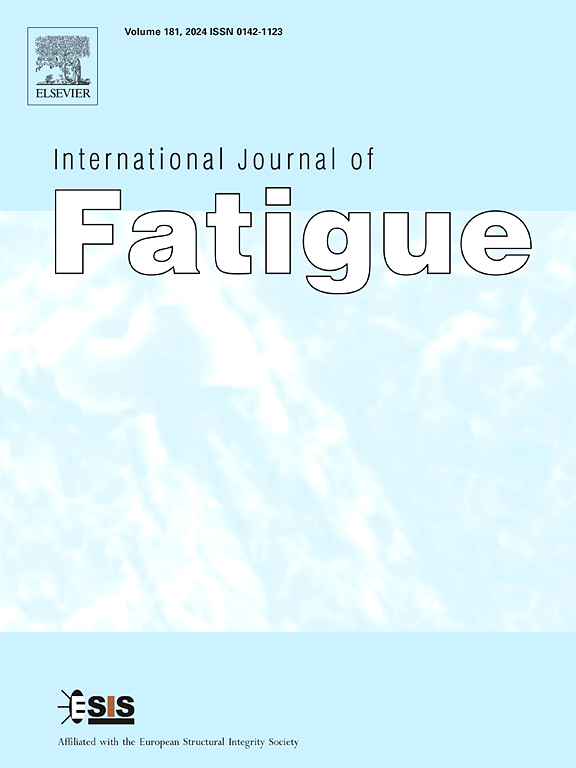Notch structural stress theory: Part Ⅲ surface roughness effect on fatigue lives
IF 5.7
2区 材料科学
Q1 ENGINEERING, MECHANICAL
引用次数: 0
Abstract
The dispersion of fatigue data is largely attributed to the effects of surface roughness, which are often overlooked in current structural fatigue assessment methodologies. This study examines the influence of surface roughness on the fatigue life of aluminum alloy notched specimens using our previously established Theory of Notch Structural Stress (TNSS). Results demonstrate a strong correlation between the IR describing the influence from structure factors and pi related to fatigue life prediction, when the maximum valley depth of the surface profile is employed as an appropriate parameter. Consequently, TNSS enables accurate fatigue life predictions across varying notch geometries and surface roughness conditions.
While surface roughness is commonly regarded as having minimal impact on fatigue performance in the presence of sharp notches, the definition of notch sharpness remains ambiguous. In respect of this point, TNSS quantifies roughness sensitivity across different notch forms within a unified physical framework, providing a generalized understanding of roughness effects on fatigue lives without disregarding the crack initiation stage.
缺口结构应力理论:零件Ⅲ表面粗糙度对疲劳寿命的影响
疲劳数据的分散很大程度上归因于表面粗糙度的影响,这在当前的结构疲劳评估方法中经常被忽视。本研究利用我们先前建立的缺口结构应力理论(TNSS)研究了表面粗糙度对铝合金缺口试样疲劳寿命的影响。结果表明,当表面轮廓的最大山谷深度作为适当的参数时,描述结构因素影响的IR与与疲劳寿命预测相关的pi之间存在很强的相关性。因此,TNSS可以在不同的缺口几何形状和表面粗糙度条件下进行准确的疲劳寿命预测。虽然表面粗糙度通常被认为在存在尖锐缺口时对疲劳性能的影响最小,但缺口锐度的定义仍然是模糊的。就这一点而言,TNSS在统一的物理框架内量化了不同缺口形式的粗糙度敏感性,在不忽略裂纹萌生阶段的情况下,提供了对粗糙度对疲劳寿命影响的广义理解。
本文章由计算机程序翻译,如有差异,请以英文原文为准。
求助全文
约1分钟内获得全文
求助全文
来源期刊

International Journal of Fatigue
工程技术-材料科学:综合
CiteScore
10.70
自引率
21.70%
发文量
619
审稿时长
58 days
期刊介绍:
Typical subjects discussed in International Journal of Fatigue address:
Novel fatigue testing and characterization methods (new kinds of fatigue tests, critical evaluation of existing methods, in situ measurement of fatigue degradation, non-contact field measurements)
Multiaxial fatigue and complex loading effects of materials and structures, exploring state-of-the-art concepts in degradation under cyclic loading
Fatigue in the very high cycle regime, including failure mode transitions from surface to subsurface, effects of surface treatment, processing, and loading conditions
Modeling (including degradation processes and related driving forces, multiscale/multi-resolution methods, computational hierarchical and concurrent methods for coupled component and material responses, novel methods for notch root analysis, fracture mechanics, damage mechanics, crack growth kinetics, life prediction and durability, and prediction of stochastic fatigue behavior reflecting microstructure and service conditions)
Models for early stages of fatigue crack formation and growth that explicitly consider microstructure and relevant materials science aspects
Understanding the influence or manufacturing and processing route on fatigue degradation, and embedding this understanding in more predictive schemes for mitigation and design against fatigue
Prognosis and damage state awareness (including sensors, monitoring, methodology, interactive control, accelerated methods, data interpretation)
Applications of technologies associated with fatigue and their implications for structural integrity and reliability. This includes issues related to design, operation and maintenance, i.e., life cycle engineering
Smart materials and structures that can sense and mitigate fatigue degradation
Fatigue of devices and structures at small scales, including effects of process route and surfaces/interfaces.
 求助内容:
求助内容: 应助结果提醒方式:
应助结果提醒方式:


